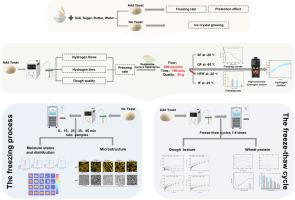分子氢熏蒸辅助浸泡下面团的冷冻动力学:质量和结构对冷冻和解冻循环的响应
IF 8.2
1区 农林科学
Q1 CHEMISTRY, APPLIED
引用次数: 0
摘要
研究了氢熏蒸辅助- 25°C浸泡冷冻(HFIF)对冷冻面团(FD)冷冻过程和整个冻融循环中质量属性的影响。结果表明,HFIF显著提高了相变速率,分别是- 25℃浸泡冷冻(IF)和- 80℃速冻(QF)的1.82倍和2.18倍。LF-NMR和MRI分析表明HFIF加速了相变和总冻结速率。HFIF使FD的形态损伤降到最低,并保持了优异的力学性能。4个循环后,与IF和QF相比,其抑制谷蛋白大分子解聚和α-螺旋含量分别提高了14.53%和14.05% (p < 0.05),抑制谷蛋白二硫键的裂解(分别比IF和QF高39.61%和14.20%)。这些发现表明,分子氢是一种创新的冷冻促进剂和冻伤保护剂,可以减轻冻融损伤。本文章由计算机程序翻译,如有差异,请以英文原文为准。

Freezing dynamics of dough under molecular hydrogen-fumigation assisted immersion: quality and structural responses to freezing and thawing cycles
The effects of hydrogen fumigation-assisted −25 °C immersion freezing (HFIF) on the freezing process of frozen dough (FD) and quality attributes throughout freeze-thaw cycles were elucidated in this study. Results showed that HFIF significantly increased the phase transition rate to 1.82 times and 2.18 times that of −25 °C immersion freezing (IF) and −80 °C quick freezing (QF), respectively. LF-NMR and MRI analyses indicated that HFIF accelerated phase transition and overall freezing rate. HFIF minimized the freezing-induced morphological damage of FD and retained superior mechanical properties. It also prevented gluten disulfide bond cleavage (39.61 % and 14.20 % higher than in IF and QF, respectively) while curtailing gluten macromolecule depolymerization and increasing α-helix content by 14.53 % and 14.05 % relative to IF and QF (p < 0.05) after four cycles. These findings suggested molecular hydrogen as an innovative freezing accelerator and frostbite protector to mitigate freeze-thaw damage.
求助全文
通过发布文献求助,成功后即可免费获取论文全文。
去求助
来源期刊

Food Chemistry: X
CHEMISTRY, APPLIED-
CiteScore
4.90
自引率
6.60%
发文量
315
审稿时长
55 days
期刊介绍:
Food Chemistry: X, one of three Open Access companion journals to Food Chemistry, follows the same aims, scope, and peer-review process. It focuses on papers advancing food and biochemistry or analytical methods, prioritizing research novelty. Manuscript evaluation considers novelty, scientific rigor, field advancement, and reader interest. Excluded are studies on food molecular sciences or disease cure/prevention. Topics include food component chemistry, bioactives, processing effects, additives, contaminants, and analytical methods. The journal welcome Analytical Papers addressing food microbiology, sensory aspects, and more, emphasizing new methods with robust validation and applicability to diverse foods or regions.
 求助内容:
求助内容: 应助结果提醒方式:
应助结果提醒方式:


